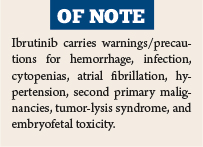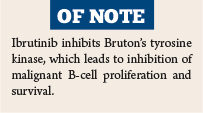In the Clinic provides overviews of novel oncology agents, addressing indications, mechanisms, administration recommendations, safety profiles, and other essential information needed for the appropriate clinical use of these drugs.
On January 19, ibrutinib (Imbruvica) was granted accelerated approved for treatment of patients with marginal zone lymphoma who require systemic therapy and have received at least one prior anti-CD20–based therapy.1
Supporting Efficacy Data
Approval was based on overall response rate in a single-arm trial in which 63 patients received ibrutinib at 560 mg once daily until disease progression or unacceptable toxicity. Disease subtypes consisted of mucosa-associated lymphoid tissue in 32 patients, nodal disease in 17, and splenic disease in 14. Patients had a median age of 66 years (range = 30–92 years), 59% were female, 84% were white, and 92% had an Eastern Cooperative Oncology Group performance status of 0 or 1. Median time since diagnosis was 3.8 years, and the median number of prior treatments was 2 (range = 1–9).

The overall response rate on independent review committee assessment was 46% (complete response in 3.2%), with response rates of 46.9%, 41.2%, and 50.0% in mucosa-associated lymphoid tissue, nodal disease, and splenic disease. The median time to response was 4.5 months (range = 2.3–16.4 months). Median duration of response was not reached (95% confidence interval = 16.7 months to not reached).
How It Works
Ibrutinib is a small-molecule inhibitor of Bruton’s tyrosine kinase, a signaling molecule of the B-cell antigen receptor and cytokine receptor pathways. Bruton’s tyrosine kinase activity via signaling through the B-cell surface receptor results in activation of pathways necessary for B-cell trafficking, chemotaxis, and adhesion. Ibrutinib forms a covalent bond with a cysteine residue in the Bruton’s tyrosine kinase active site, leading to inhibition of Bruton’s tyrosine kinase enzymatic activity. Preclinical studies have shown that ibrutinib inhibits malignant B-cell proliferation and survival in vivo and cell migration and substrate adhesion in vitro.
How It Is Given
The recommended dose of ibrutinib in marginal zone lymphoma is 560 mg orally once daily until disease progression or unacceptable toxicity.
Ibrutinib treatment should be interrupted for grade 3 or higher nonhematologic toxicities, grade 3 or higher neutropenia with fever, and grade 4 hematologic toxicities. With resolution of toxicity to grade 1 or baseline status, treatment can be reinitiated at the starting dose. The dose may be reduced to 280 mg and then to 140 mg for second and third recurrence; treatment should be discontinued for a fourth recurrence.
Expanded Approval of Ibrutinib
- Ibrutinib (Imbruvica) was granted accelerated approved for treatment of patients with marginal zone lymphoma who require systemic therapy and have received at least one prior anti-CD20–based therapy.
- The recommended dose of ibrutinib in marginal zone lymphoma is 560 mg orally once daily until disease progression or unacceptable toxicity.
Coadministration with strong or moderate CYP3A inhibitors should be avoided, and alternative agents with less CYP3A inhibition should be considered. Concomitant use of strong CYP3A inhibitors that would be taken chronically (eg, ritonavir, indinavir [Crixivan], nelfinavir [Viracept], saquinavir [Invirase], boceprevir [Victrelis], telaprevir [Incivek], nefazodone) is not recommended. For short-term use (≤ 7 days) of strong CYP3A inhibitors (eg, antifungals and antibiotics) interruption of ibrutinib until the CYP3A inhibitor is no longer needed can be considered. If a moderate CYP3A inhibitor must be used (eg, fluconazole, darunavir [Prezcobix, Prezista], erythromycin, diltiazem, atazanavir, aprepitant, amprenavir [Agenerase], fosamprenavir, crizotinib [Xalkori], imatinib, verapamil, ciprofloxacin), the ibrutinib dose should be reduced to 140 mg. Patients taking concomitant strong or moderate CYP3A inhibitors should be monitored more closely for ibrutinib toxicity.

For patients with mild liver impairment (Child-Pugh class A), the recommended ibrutinib dose is 140 mg daily. Ibrutinib should be avoided in patients with moderate or severe hepatic impairment (Child-Pugh classes B and C).
Safety Profile
In the 63-patient trial, the most common adverse events of any grade were fatigue (44%), diarrhea (43%), bruising (41%), musculoskeletal pain (40%), and hemorrhage (30%). The most common grade 3 or 4 adverse events were pneumonia (10%), fatigue (6%), diarrhea (5%), rash (5%), and hypertension (5%). Grade 3 or 4 laboratory abnormalities included neutropenia in 13%, anemia in 13%, and thrombocytopenia in 6%.
In overall experience with ibrutinib, blurred vision and decreased visual acuity of grade 1 or 2 has occurred in 10% of patients.
Report Adverse Events
Health-care professionals should report all serious adverse events suspected to be associated with the use of any medicine or device to FDA’s MedWatch Reporting System by completing a form online at http://www.fda.gov/medwatch/report.htm, by faxing (1-800-FDA-0178), by mailing the postage-paid address form provided online, or by telephone (1-800-FDA-1088).
Ibrutinib carries warnings/precautions for hemorrhage, infection, cytopenias, atrial fibrillation, hypertension, second primary malignancies (including skin cancers and other carcinomas), tumor-lysis syndrome, and embryofetal toxicity. Patients must be monitored for bleeding, fever and infection, blood pressure, and atrial fibrillation. Complete blood cell counts should be monitored monthly.
Women must be advised of the potential risk to a fetus and to avoid pregnancy while taking the drug and for 1 month after stopping treatment. Men must be advised to avoid fathering a child during the same period. ■
Reference
1. Imbruvica (ibrutinib) capsules prescribing information. Pharmacyclics LLC, Janssen Biotech, Inc, January 2017. Available at https://www.imbruvica.com/prescribing-information. Accessed February 23, 2017.

